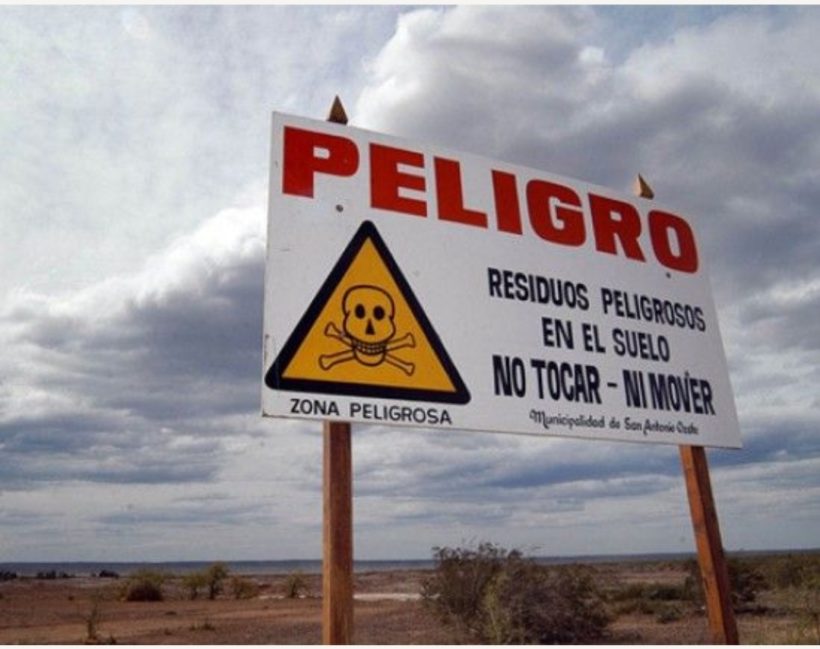The legacy of mining in San Antonio Oeste: Current health risks, due to contamination effects of open-pit mining.
We interviewed Patricia Llonch, member of the Multisectoral Commission for the lead problem in San Antonio Oeste, located in the coastal town of the Province of Río Negro, in Argentina.
By Laura Hernández
REHUNO: How did the Gonzalito Mine come about?
Patricia Llonch: The Gonzalito Mine operated from the 1950s to the 1980s, mining mainly lead, zinc and silver.
The material extracted at the mine was processed in the smelter installed by the company Geotécnica S.A. in the neighbouring town of San Antonio Oeste.
REHUNO: What treatment was given to the slag from the mining processes?
Patricia Llonch: During all the years that the mine operated, it was deposited in the open air. Directly on bare ground in the area to the west of the town. In the mid-1980s the company went bankrupt and the deposits were abandoned.
REHUNO: Were there ever any health controls on the population?
Patricia Llonch: On the scene there was work done in San Antonio Oeste. Prof. Dr. Susana I. García, then in charge of the National Programme for the Prevention and Control of Poisoning, reported in multiple papers on the problem related to contamination.
REHUNO: What were the results of the evaluations?
Patricia Llonch: From the health risk assessments, the presence of lead, arsenic, cadmium, tin, copper, antimony, zinc and other metals at the site was confirmed. Poisoning of children with unacceptable levels of lead in blood and arsenic in urine was also demonstrated.
Exposure biomarker studies were only conducted for lead and arsenic. But unacceptable levels of contamination were observed in some local people. This indicated that it was necessary to consider the possibility of exposure to metals such as cadmium, with carcinogenic potential.
As far as lead is concerned, it has been reported that even small but sustained childhood exposures (plombemia below 5 μg/dl) result in neuromotor impairment, irreversible loss of intelligence, behavioral problems and poor school performance. These adverse effects are more severe and irreversible when exposure occurs during the first 2 years of life.
It is important to note here that children under two years of age have not been studied, as they are generally excluded from population-based studies due to the difficulties involved in approaching this segment of the population. However, the exposure scenarios justify considering them as high-risk and the main target of remediation actions.
On the other hand, the presence of metals such as arsenic and cadmium leads to an unacceptable increase in the risk of cancer in several of the sites analysed.
REHUNO: How do you assess the degree of exposure to lead?
Patricia Llonch: To assess the degree of human exposure, blood lead concentration is usually measured. But there is no level of lead exposure that can be considered safe. Lead poisoning is entirely preventable.
REHUNO: What are the consequences of lead on human health?
Patricia Llonch: Lead is a toxic substance, with particularly harmful effects on young children.
Small but sustained exposures result in neuromotor disturbances, irreversible loss of intelligence and behavioral problems.
The World Health Organisation in its document “Lead poisoning and health” indicated that lead is a toxic substance. It accumulates in the body, affecting various systems of the organism. With particularly harmful effects on young children. It is estimated that lead exposure in children causes 600,000 new cases of intellectual disability each year.
Lead exposure claims an estimated 143,000 lives each year, with the highest mortality rates in developing regions. Lead is distributed throughout the body reaching the brain, liver, kidneys and bones. It is deposited in bones and teeth and accumulates over time.
REHUNO: Could you tell us about environmental liabilities and the struggle of the multisectoral?
Patricia Llonch: The multisectorial has been fighting for 17 years for the remediation of contaminated land in San Antonio Oeste. The Inalafquen Foundation in particular – a member of the multisectorial – has been fighting for more than twenty-five years. A remediation was achieved but was not completed due to gross management errors on the part of the responsible authorities, and an undetermined amount of toxic soil is still present in the urban and peri-urban areas of San Antonio Oeste. Our children are still threatened.










